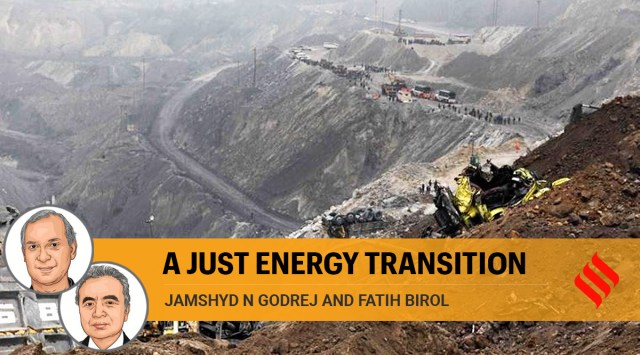- India
- International
What India needs for a just energy transition
Focus on livelihoods, especially of those working in coal mines and fossil-fuel power plants, and a people-centric approach.
 To achieve the trifecta of jobs, growth and sustainability, India must strive to put people at the centre of its energy transformation.
To achieve the trifecta of jobs, growth and sustainability, India must strive to put people at the centre of its energy transformation.Energy transitions are gaining momentum worldwide, and India is no exception. The country has achieved the remarkable double leapfrog of connecting nearly all households to electricity while also creating one of the world’s largest markets for renewable energy. But ensuring that the opportunities of India’s transition are shared fairly throughout society — and workers and communities are not left to face the challenges alone — is not an easy task, given the country’s population and diversity. To achieve the trifecta of jobs, growth and sustainability, India must strive to put people at the centre of its energy transformation.
With an ever-growing list of countries announcing net-zero emissions targets, the global energy system is set to undergo a transformation in the coming decades. According to an IEA analysis, 90 per cent of new electricity generation capacity around the world now comes from renewables.
In India, that energy transformation is well underway. It is among the world’s top five countries in terms of renewable power capacity. Its ambitious target to increase India’s renewable energy capacity to 450 gigawatts (GW) by 2030 would help move it closer to achieving the country’s broader climate goals. By then, low-carbon energy sources could account for more than 60 per cent of India’s total power capacity, well above what it originally committed to under the Paris Agreement. India is also showing global clean energy leadership through initiatives such as the International Solar Alliance, which has more than 70 member countries.
Boosting clean energy investments brings immediate gains, including job creation and new economic opportunities. According to the Council on Energy, Environment and Water (CEEW), the deployment of 450 GW of renewables would employ more than half a million workers. But not everyone benefits immediately or equally. Emerging and developing economies are starting from different baselines than advanced economies and they must tailor their pathways to ensure their transitions are inclusive.
In India’s case, new jobs would need to be found over time for the coal miners affected by the changes, as well as for people who work in the fossil fuel power plants that will close down. Many will need retraining for work in other sectors. Credible severance packages and insurance cushions would also help make the transition easier to navigate. Policymakers must earmark special “transition funds” to help coal-dependent regions, some of which are among India’s poorest, to remodel their economies and develop new industries.

Energy subsidies must be rationalised and directed towards those who need them most. This would help sustain the gains of the Saubhagya and Ujjwala schemes, which have successfully extended energy access to some of India’s most underserved areas. Fiscal resources freed up through subsidy reform should then be invested in clean energy solutions, especially in underdeveloped regions and marginalised communities.
 A just transition should focus on how clean energy can support rural livelihoods and increase communities’ resilience in the aftermath of the pandemic shock. It can do this through a focus on how to share the benefits of clean energy technologies with micro-entrepreneurs and small businesses. In rural India, clean energy innovations for farms and businesses offer a market opportunity worth more than $50 billion. The energy transition in rural India can be driven by dedicated policies to promote renewables, incentivise investment in decentralised low-carbon power sources like rooftop solar, and train and build the capacity of clean energy entrepreneurs.
A just transition should focus on how clean energy can support rural livelihoods and increase communities’ resilience in the aftermath of the pandemic shock. It can do this through a focus on how to share the benefits of clean energy technologies with micro-entrepreneurs and small businesses. In rural India, clean energy innovations for farms and businesses offer a market opportunity worth more than $50 billion. The energy transition in rural India can be driven by dedicated policies to promote renewables, incentivise investment in decentralised low-carbon power sources like rooftop solar, and train and build the capacity of clean energy entrepreneurs.
While India’s energy transition will create many new jobs, the limited participation of women in the growing green workforce must be addressed. According to a 2019 study by CEEW and the IEA, women account for nearly 32 per cent of the renewables workforce globally but only around 11 per cent of the rooftop solar workforce in India. As a priority, renewable energy companies must promote policies to ensure gender parity in their workforce. These could include investments in suitable facilities for women at project sites, designing guidelines for flexible working arrangements, and creating programmes to prepare more women for leadership roles.
In the short term, stimulus spending in the labour-intensive construction sector could accelerate progress on the Affordable Housing Mission. Incorporating energy efficiency and green construction methods into these projects could ensure millions of homes enjoy thermal comfort, and help make energy efficiency a core part of building designs. Many local jobs could also be promoted by the Make in India Initiative, particularly if it is focused on manufacturing energy-efficient appliances, battery technologies and components for renewable energy systems.
Finally, engaging the youth is critical to ensure that the energy transition is sustainable, inclusive and enduring. It is the emerging generation of innovators and entrepreneurs that will provide the technical and social solutions of the future. Young entrepreneurs in India have already shown their impact by expanding the footprint of renewables and disrupting traditional energy models.
Some of these key themes are being explored by the 30 members of the Global Commission on People-Centred Clean Energy Transitions, which the IEA launched in January. The Global Commission will make recommendations in advance of the COP-26 Climate Change Conference in November on how to empower citizens and communities to both seize the opportunities and navigate the disruptions of the energy transition.
India’s energy transition is already an inspiration for many emerging economies. A people-centric approach, backed by good policy design, will not only help India build a clean and inclusive energy future, but could also provide a model for other countries and communities worldwide.
This column first appeared in the print edition on August 4, 2021 under the title ‘A just energy transition’. Godrej is Chairperson of the Council on Energy, Environment and Water (CEEW) and a member of IEA’s Global Commission on People-Centred Clean Energy Transitions. Birol is Executive Director of the International Energy Agency (IEA).
EXPRESS OPINION
More Explained
Apr 26: Latest News
- 01
- 02
- 03
- 04
- 05











































